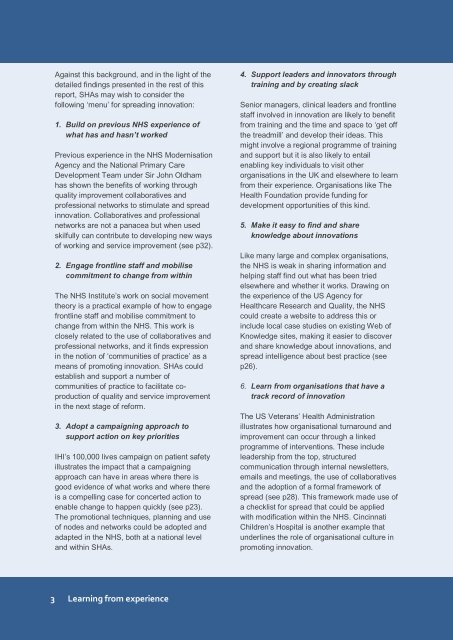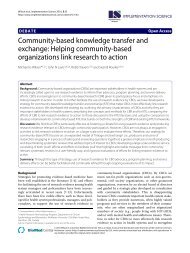Promoting and Embedding Innovation
Promoting and Embedding Innovation
Promoting and Embedding Innovation
You also want an ePaper? Increase the reach of your titles
YUMPU automatically turns print PDFs into web optimized ePapers that Google loves.
Against this background, <strong>and</strong> in the light of the<br />
detailed findings presented in the rest of this<br />
report, SHAs may wish to consider the<br />
following „menu‟ for spreading innovation:<br />
1. Build on previous NHS experience of<br />
what has <strong>and</strong> hasn’t worked<br />
Previous experience in the NHS Modernisation<br />
Agency <strong>and</strong> the National Primary Care<br />
Development Team under Sir John Oldham<br />
has shown the benefits of working through<br />
quality improvement collaboratives <strong>and</strong><br />
professional networks to stimulate <strong>and</strong> spread<br />
innovation. Collaboratives <strong>and</strong> professional<br />
networks are not a panacea but when used<br />
skilfully can contribute to developing new ways<br />
of working <strong>and</strong> service improvement (see p32).<br />
2. Engage frontline staff <strong>and</strong> mobilise<br />
commitment to change from within<br />
The NHS Institute‟s work on social movement<br />
theory is a practical example of how to engage<br />
frontline staff <strong>and</strong> mobilise commitment to<br />
change from within the NHS. This work is<br />
closely related to the use of collaboratives <strong>and</strong><br />
professional networks, <strong>and</strong> it finds expression<br />
in the notion of „communities of practice‟ as a<br />
means of promoting innovation. SHAs could<br />
establish <strong>and</strong> support a number of<br />
communities of practice to facilitate coproduction<br />
of quality <strong>and</strong> service improvement<br />
in the next stage of reform.<br />
3. Adopt a campaigning approach to<br />
support action on key priorities<br />
IHI‟s 100,000 lives campaign on patient safety<br />
illustrates the impact that a campaigning<br />
approach can have in areas where there is<br />
good evidence of what works <strong>and</strong> where there<br />
is a compelling case for concerted action to<br />
enable change to happen quickly (see p23).<br />
The promotional techniques, planning <strong>and</strong> use<br />
of nodes <strong>and</strong> networks could be adopted <strong>and</strong><br />
adapted in the NHS, both at a national level<br />
<strong>and</strong> within SHAs.<br />
4. Support leaders <strong>and</strong> innovators through<br />
training <strong>and</strong> by creating slack<br />
Senior managers, clinical leaders <strong>and</strong> frontline<br />
staff involved in innovation are likely to benefit<br />
from training <strong>and</strong> the time <strong>and</strong> space to „get off<br />
the treadmill‟ <strong>and</strong> develop their ideas. This<br />
might involve a regional programme of training<br />
<strong>and</strong> support but it is also likely to entail<br />
enabling key individuals to visit other<br />
organisations in the UK <strong>and</strong> elsewhere to learn<br />
from their experience. Organisations like The<br />
Health Foundation provide funding for<br />
development opportunities of this kind.<br />
5. Make it easy to find <strong>and</strong> share<br />
knowledge about innovations<br />
Like many large <strong>and</strong> complex organisations,<br />
the NHS is weak in sharing information <strong>and</strong><br />
helping staff find out what has been tried<br />
elsewhere <strong>and</strong> whether it works. Drawing on<br />
the experience of the US Agency for<br />
Healthcare Research <strong>and</strong> Quality, the NHS<br />
could create a website to address this or<br />
include local case studies on existing Web of<br />
Knowledge sites, making it easier to discover<br />
<strong>and</strong> share knowledge about innovations, <strong>and</strong><br />
spread intelligence about best practice (see<br />
p26).<br />
6. Learn from organisations that have a<br />
track record of innovation<br />
The US Veterans‟ Health Administration<br />
illustrates how organisational turnaround <strong>and</strong><br />
improvement can occur through a linked<br />
programme of interventions. These include<br />
leadership from the top, structured<br />
communication through internal newsletters,<br />
emails <strong>and</strong> meetings, the use of collaboratives<br />
<strong>and</strong> the adoption of a formal framework of<br />
spread (see p28). This framework made use of<br />
a checklist for spread that could be applied<br />
with modification within the NHS. Cincinnati<br />
Children‟s Hospital is another example that<br />
underlines the role of organisational culture in<br />
promoting innovation.<br />
3 Learning from experience
















